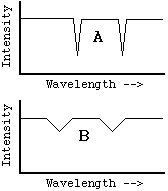
b) (7 pts) If we were to observe using some kind of red filter that only enabled us to see the red wavelengths of light being emitted by each star, which would appear brighter? Explain your answer.
Answer any 7 of the following 8 questions. All relevant equations have been given on the cover page (not visible in WWW version). Each is worth 14 points.
1) Two trigonometric distance determination techniques weıve used in class involve angular diameter and parallax.
2) The parallax method of distance determination is only useful for stars within a certain distance from Earth.
3) Below is the spectrum of Arcturus, plotted on the same graph as a spectrum of our own Sun for comparison purposes. Note that the Sun peaks in the middle of the visible region of the spectrum, which gives it a yellowish color. Arcturus, with its cooler surface temperature, peaks at a somewhat longer wavelength.

b) (7 pts) If we were to observe using some kind of red filter that only enabled us to see the red wavelengths of light being emitted by each star, which would appear brighter? Explain your answer.
4) The law of scattering says that shorter wavelengths of light tend to be scattered more effectively by gas and dust than longer wavelengths. Use this principle to explain why the sky is blue and why the Sun appears to be red during sunset (much more red than when it is directly overhead...explain the color difference).
5) Two stars, A and B, both of the same temperature and the same abundance of Calcium, resulting in the Calcium absorption line pattern you see below for both stars. Assume neither star has a significant rotation speed in this problem, and assume both stars have the same mass. Assume both lines have the same strength.

6) Explain why the temperature of a star has an effect on the strength of the spectral lines in that starıs spectrum. Specifically, state why spectral line strength for certain elements gets weaker at very low temperatures *and* at very high temperatures.
7) Limb darkening is a phenomenon seen in the photosphere of the Sun, and its existence tells us something about the temperature structure of the photosphere.
8) We know that the corona is a region of extremely hot gas surrounding the Sun, and gas in the corona often reaches temperatures of several million degrees.